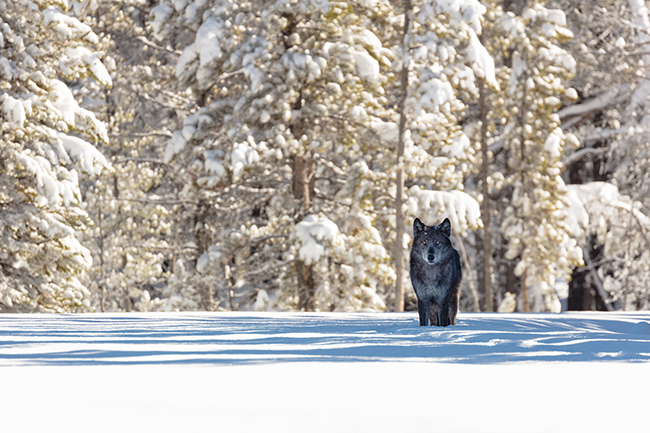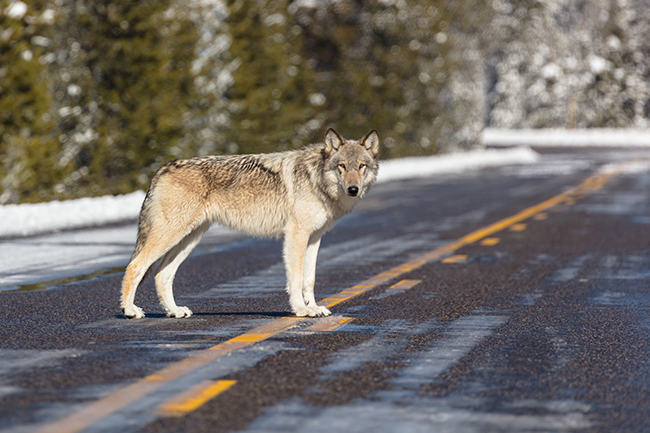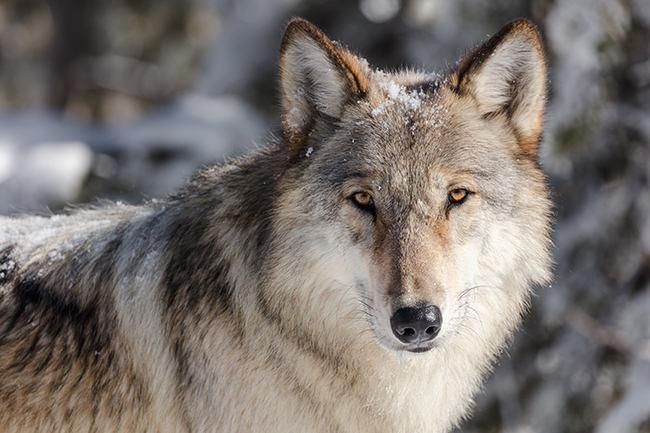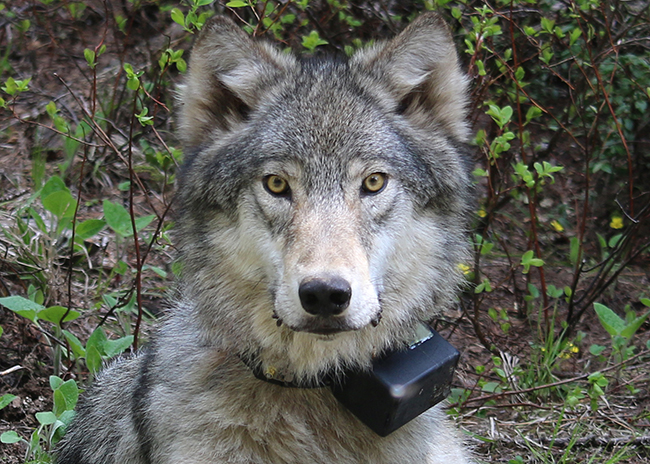Return of the Pack
05 Dec 2023
How ‘Defenders of Wildlife’ are bridging the great divide of wolf reintroduction and management in Colorado
By Grace Adele Boyle

Of all the proposed methods for conserving Colorado’s ecological future, bringing wolves back to the Western Slope is one of the most contentious. While the majority of Colorado voted yes on Proposition 114, the ballot measure tasking Colorado Parks and Wildlife (CPW) with reintroducing and managing gray wolves, the margin was razor thin (50.9% for, 49.1% against) and fell largely along urban and rural boundaries, respectively.
Since most of Colorado’s landscape is rural yet most residents live in the urban Front Range, wolf reintroduction is more conceptual vs paws on the ground experiential. “I’d like them to be around, I just want them to leave me alone,” is the general consensus—and fair enough. Wolves are apex predators, and their presence has far-reaching impacts on wildlife and livestock.
That’s exactly why the leading U.S. conservation organization ‘Defenders of Wildlife’ (Defenders) worked so hard to get Prop 114 on the ballot and passed in 2020.
“Wolves are an incredibly important part of the overall ecosystem in Colorado,” explains Shawn Cantrell, VP of Field Conservation for Defenders. The correlation between Colorado’s long-term ecological health and its gray wolf population is indisputable.
Wolves help maintain ungulate populations, including reducing disease, minimizing winter mortality and improving overall herd health. The presence of wolves can prevent ungulates from overgrazing, which is particularly important along riparian areas where mature shrubbery provides habitat for different species. Larger vegetation increases shade, cooling water temperatures, decreasing evaporation and creating a healthier habitat for fish and other aquatic species. “It’s a web—you take one piece out, particularly an apex predator at the top, and it ripples down through the system,” Cantrell explains.

Because the biodiversity web doesn’t stop or start at Colorado’s border, the impact is sweeping. “Colorado is this missing piece regarding wolf recovery in the United States. Once wolves are reintroduced to Colorado, we will be reconnecting wolf populations from Mexico all the way up to the Arctic—that’s a big achievement that Colorado should be proud of,” explains Kaitie Schneider, Colorado Wolf Representative for Defenders.
Gray wolves are native to Colorado but unregulated hunting throughout the 1800s brought their prey-base down to critical levels. By the early 1900s, bison had been eradicated from Colorado, big horn sheep were steadily declining, and—hard to believe—the elk population had dipped to just 1,000 in Colorado. All big game across the West had been hunted to the brink, so wolves turned to the increasing livestock industry for sustenance.
In an effort to protect the livelihood of ranchers and farmers and rebalance the ecological scale that had been inadvertently tipped, the Western States overcorrected. Government-sponsored eradication efforts against wolves and other carnivores including coyotes, lynxes, bears and mountain lions were systematically executed. While individuals and communities could see the environmental impact of decimating so many species, it took the environmental movement of the ‘60s and ‘70s to push—of all people, President Richard Nixon—to create the Environmental Protection Agency and sign the Endangered Species Act into law. This means for nearly 50 years, gray wolves have been protected under a combination of Federal and State law, but Colorado is the first state to pass legislation (Prop 114) to reintroduce and manage gray wolves. “Wolves help control all species in the web, including other carnivores, making this restoration not only important for wolves but for the future of Colorado’s wild places,” Schneider explains.
Reintroducing an apex predator back into the balance means elk won’t settle in one area for as long, sometimes making them harder to find. Because of this, some hunters understandably consider wolves competition. Yet the reality illustrated through 26+ years of studies in the Northern Rockies around wolf reintroduction shows that the number of hunting trips where hunters have successfully harvested a deer or elk remains consistently high.
Still, to some rural western slope communities, reintroduction feels like ending up where they started even if wolves end up where they belong. The question is not if but how reintroducing wolves will impact their lives and that’s why the ‘management’ portion of Prop 114 is so essential.
CPW has worked diligently to create a scientifically backed wolf management and reintroduction plan that serves all of Colorado. They’ve held statewide hearings to create an open dialogue and build relationships between different viewpoints and experiences. They’ve worked with a diverse Stakeholder Advisory Group (SAG) and are coordinating with wolf managers from other states and science advisors to address the social, economic and ecological needs that arise with wolf reintroduction. Defenders and CPW believe the entire process needs the essential voices of Colorado’s diverse communities: conservationists, hunters, Native American communities, the livestock industry, agricultural producers, environmentalists, landowners and recreation enthusiasts. There is no way consensus will be reached on every issue and that’s the point—to have diverse values in the decision-making process instead of an intellectual monoculture.

The plan’s goal is, “To recover and maintain a viable, self-sustaining wolf population in Colorado, while concurrently working to minimize wolf-related conflicts with domestic animals, other wildlife and people.” The plan also includes compensation for livestock lost to wolves and ideal timing for reintroducing 10-15 wolves per year for 3-5 years. CPW is on track to meet the voter-approved deadline of Dec 31, 2023, for the first wolves to be released via helicopter transport on the Western Slope.
The bottom line is that Colorado’s rural communities, who largely voted against wolf reintroduction, are expected to be impacted more than the urban Front Rangers who voted for Prop 114. Defenders is aware of this reality and is dedicated to supporting rural residents.
“Most rural communities live on the edge, and ranchers can feel particularly stressed. They are facing many pressures on their business model: climate change, water shortages and rising prices. And they see wolves as potentially another threat to their ability to make a living. So, if we can help make sure that they are secure, we are hoping they will be supportive of wolf recovery,” Cantrell shares.
“Most of our work in Colorado includes hosting workshops and directly implementing wolf conflict-minimization tools with ranching communities,” Schneider says. “It is not my place to go onto someone’s ranch and tell them to change how they’ve been ranching for the last 100 years—but we can help people develop a strategic approach to minimizing wolf conflicts so there’s less stress on them and their livestock.”
Schneider and Cantrell are passionate about their work and grounded in their approach. They know that there’s no single tool to prevent every attack, but 30+ years of working with ranchers has proven that using these methods can dramatically reduce the likelihood of predation.
Much of the success of the wolf program in Colorado will depend on public officials hearing from constituents over the next several years—repeatedly. Whatever can be said about a particular elected official, representatives get the temperature of the social waters through their outspoken constituents, and they do a decent job of listening. State representatives like Governor Jared Polis, Congressman Lauren Boebert, Senator Michael Bennet and your local county representatives need to hear from you. The exact wording doesn’t matter but communicating the sentiment, “I’m excited wolves are back, please support the reintroduction of wolves,” is essential. Because if they don’t hear from supporters, they will certainly hear the complainers over the next few years. Even if it’s a small number, if that’s all they hear, it will be impactful.
If you want to support the wolf reintroduction efforts in Colorado, Defenders of Wildlife are always looking for advocates. “We send out action alerts when opportunities pop up to get involved. Anyone can sign up on our website no matter where you live, you’ll get notifications for your exact area,” Schneider shares.
Another way you can let everyone know you’re supporting Colorado’s wolves is by signing up for the wolf emblazoned ‘Born To Be Wild’ license plate in January 2024. The money raised goes directly to nonlethal wolf-livestock conflict prevention for CPW.

Low-stress Livestock Handling
This training reduces vulnerability to predation (wolf or otherwise) and increases the livestock’s ability to handle pressure. So, if a wolf does come, the cattle don’t scatter, maintaining safety in the herd, and wolves lose interest and leave to find easier prey.
Turbo Fladry
“Think used car lot—it’s electrified wire with red flagging on it,” Schneider explains. “Wolves don’t like new and unknown things, so if they come to check out cattle and see fladry, they won’t like it and will leave. This method works best in rotation and in conjunction with other tools, so wolves don’t become accustomed to it.”
Range Riding
Human presence, typically on horseback. Being with the herd, removing sick or injured cows that could lure a wolf, noticing when cattle wander off and keeping them together, all while monitoring for signs of wolves.
RAG Box
Radio Activated Guard (RAG) boxes are programmed to respond to wolf radio collars with flashing lights and speakers to ward them away. If a wolf wanders within a certain distance of the RAG box, lights start flashing, music begins blasting and the wolves run. Originally, RAG boxes were difficult to obtain until Defenders worked with a manufacturer to redesign a compact, reliable and accessible model with a notification system that directly lets ranchers know when their RAG box gets activated so they can send a range rider immediately.
Fox Lights
A portable light that flashes random patterns. “Imagine you’re hiking with a group of six ten-year-olds, and they all have their own flashlights—lights are going up to the tops of trees, in people’s eyes, just standing around—that’s what a Fox Light is like. No pattern, no logic, just chaos. And wolves hate it,” Cantrell explains.












